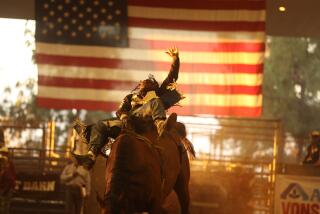Horse Cavalry Buffs Bivouac at Hotel to Toast Glory Days
- Share via
Retired Col. Pat Patterson has the answer to the gasoline shortage--bring back the horse cavalry.
“It’s going to have to come back,” Patterson said, reminiscing about how he formed his own unofficial cavalry in Vietnam. “I used 275 Mongolian ponies and 10 elephants to evacuate the wounded and carry supplies to places where helicopters couldn’t land. And that was when we had gas.”
Patterson and other horse cavalry aficionados are bivouacked at a luxury hotel in Woodland Hills this weekend to celebrate the dashing figures in boots, blue coats, gold-striped pants and sabers, indelibly drawn and polished by John Ford in his classic trilogy. Friday, a transfixed audience watched one of the movies, “Rio Grande,” starring a youthful John Wayne.
The three-day, 14th annual convention of the U.S. Horse Cavalry Assn. also includes a polo game and a ceremony honoring deceased cavalrymen--who, according to legend, always stop for a drink of water on their way to hell, where they invariably end up because of their hard-living ways.
Many of the 300 people who flew in from as far away as Florida for the convention served in mechanized and air cavalry divisions of the U.S. Army during World War II and the Vietnam and Korean conflicts. Some have relatives who rode in the horse cavalry before it was dismounted in the early 1940s.
“I’ll never forget when Dad lost his horse and got his Jeep, it was sad,” said retired Maj. Gen. Jim Smith, 67, of St. Petersburg, Fla. “But we youngsters knew it had to happen.”
Also attending the convention is retired Col. Ed Ramsey, 73, who claims he led a cavalry charge on horseback in the Philippines on Jan. 16, 1942. Ramsey has just written a book called “Lieutenant Ramsey’s War,” detailing the story.
“I divided the 27 men in my platoon into three squads to go down into the village when the Japanese opened fire,” Ramsey said Friday in an interview. “I deployed the men into a line; we were at raised pistols, and I gave the order to charge into the village, right into the 100 or so Japanese.
“It was a typical cavalry charge. We hit them instinctively. There was no hesitation--my men were magnificent.”
Ramsey’s account may be accurate, but it has not been verified, said Dennis Vetock, a historian at the U.S. Army Military History Institute in Carlisle, Pa. The last documented cavalry charge was in 1916 in the search for Pancho Villa in Mexico, he said.
The cavalrymen in the Philippines ended up “eating most of their horses” because of a food shortage, Vetock said.
But Ramsey said he and his men didn’t eat the animals, including his chestnut gelding named Bryn Awryn, until after the battle at the Morong village.
Ramsey is one of the many people attending the convention who believe the horse cavalry has a role to play in modern warfare, particularly in remote places where vehicles cannot travel.
“It’s a love affair with horses,” said Vetock, adding jokingly, “but somebody had to clean the stables and they’re forgetting that.”
The association was doing a brisk business Friday in horse souvenirs. Particularly popular were black, yellow and gold plastic bolo ties featuring the group’s motto, “We Remember,” and a reproduction of Western painter Frederic Remington’s painting of a cavalryman in the group’s heyday in the late 1800s.
“What I like about horses is they don’t talk back to you and they’re affectionate,” said retired Col. Jim Spurrier of El Paso, who formed the association in 1976.
Life for the wives of cavalrymen in the West, where the mounted soldiers were fighting against the Indians, was a “glittering misery,” said Gail Leonard, a Chino elementary school teacher and Western history buff, who gave a lecture Friday at the convention. “They were always being entertained by soldiers at the stations, but there were bugs, and it was dusty and dirty,” she said.
But entire families shared a love for the service, she said. Paraphrasing a mid-1800s anonymous quotation by a British applicant for the cavalry, Retired Gen. James H. Polk of El Paso said, “The cavalry lent tone, dash and color to what otherwise would be a vulgar brawl.”
Sally Janis of Sacramento, quoting a modern bumper sticker, put it more simply: “If you ain’t cav, you ain’t.”
More to Read
Get the L.A. Times Politics newsletter
Deeply reported insights into legislation, politics and policy from Sacramento, Washington and beyond. In your inbox twice per week.
You may occasionally receive promotional content from the Los Angeles Times.










